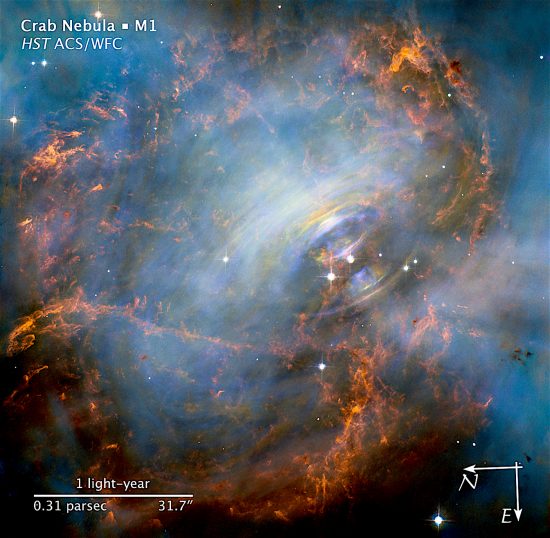
Credit: NASA, ESA, and Z. Levay (STScI). Acknowledgment: J. Hester (ASU) and M. Weisskopf (NASA/MSFC)
Jul 8, 2016
Various celestial phenomena are associated with the Crab Nebula.
In 1054, ancient Chinese astrologers first saw a “guest star” in the constellation Taurus. They noted that it was bright enough to see during daylight hours. About a year later it faded out. John Bevis observed a bright nebula near that location in 1731, while Charles Messier recorded his observation in 1758. William Parsons, the third Earl of Rosse, using a 72-inch, four ton metal mirror telescope called “the Leviathan of Parsonstown”, wrote that the nebula resembled a crab’s claw, so it came to be called the Crab Nebula. Astronomer Knut Lundmark identified it with the Chinese supernova in 1921. In 1928, Edwin Hubble proposed that the nebula was the remains of the historical supernova.
Radio astronomers discovered an associated pulsar in 1968. It was also found to be an optical and X-ray radiation source. The Crab Nebula pulsar blinks at 30 times per second, so astronomers conclude that the central star “must be” rotating at 30 times per second.
Pulsars are thought to be the leftovers after a star “blows off” its outer layers, leaving behind a dense core. Electrons in the remaining stellar core are said to be gravitationally compressed until they combine with nuclear protons, forming matter so dense that a single teaspoon would weigh billions of tons on Earth.
The evidence for neutron stars is indirect and none can be observed. What is observed are intense magnetic fields pulsing in fractions of a second. Electric Star theory proposes that neutron stars are imaginary objects. A gravity-only cosmology requires them because the forces generated by spinning billions of megatons as fast as a power drill would cause the star to tear itself apart.
One of the most difficult problems associated with neutron stars is that they violate the “Island of stability” principle. The number of neutrons plotted against the number of protons in elemental nuclei reveals a ratio of about one-to-one for light elements and one point five-to-one for heavier ones. Anything outside that range will spontaneously decay until it reaches equilibrium. Too few neutrons and atoms will emit protons until they stabilize or vice versa. Therefore, an atomic nucleus consisting of neutrons alone would be unstable and immediately decay.
Since magnetic fields are induced by electric currents, there must be electricity generating the intense fields in a pulsar. Those “feeder currents” must also be part of a circuit, since electric charge must flow in a completed circuit. Electric Universe advocates speculate that the oscillations in pulsars are caused by resonant effects in those circuits. The sudden release of stored electrical energy in a “double layer” is responsible for their outbursts.
As noted in the past, Hannes Alfvén thought that the “exploding double layer” should be considered a new class of celestial object. It is double layers in space plasmas that form most of the observed unusual structures. Z-pinches in plasma filaments create plasmoids that evolve into stars and galaxies. Electricity is responsible for the birth of stars, and when the current density gets too high double layers catastrophically release their excess energy and appear as gamma-ray bursts, X-rays or flares of ultraviolet light.
As Alfvén said in his 1970 Nobel Prize acceptance speech: “… it is obvious that astrophysics runs the risk of getting too speculative, unless it tries very hard to keep contact with laboratory physics. Indeed it is essential to stress that astrophysics is essentially an application to cosmic phenomena of the laws of nature found in the laboratory. From this follows that a particular field of astrophysics is not ripe for a scientific approach before experimental physics has reached a certain state of development.”
Stephen Smith












